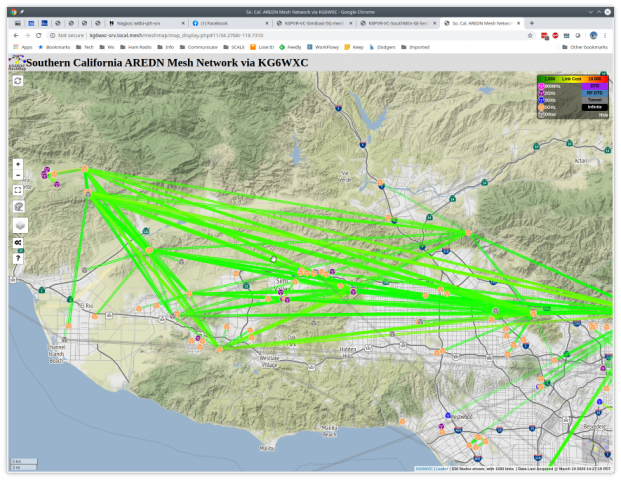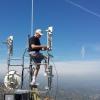In Ventura County, our backbone is primarily made of Ubiquiti AirOS radios. They link the AREDN nodes on 10 sites together via DtD (in a dedicated VLAN2). The AirOS nodes look like a mesh network to the AREDN nodes with a path to each AirOS node, and all of them almost equal LQ/NLQ DtD links.
The issues with how the current implementation of OLSR handles route flapping lead to frequent periods where the mesh network is unusable due to routes failing back and forth between the various (virtual) paths on the backbone.
We've not been able to figure out how to configure AirOS to look like a star network instead of a mesh network for the AREDN nodes. If someone could point us to any documentation on that we'd be grateful. (And no, as much as we'd like to convert the backbone from Part 15 to Part 97, it's still carrying some commercial traffic).
As an alternative, we tried setting up a separate VLAN between two of the sites on the Part 15 link and tunneling two AREDN nodes between this. However, we couldn't make it work, most likely because the node is only listening to VLAN2 for DtD broadcasts on VLAN2 (doh) and not on the different VLAN we set up between the two sites. Again if anyone currently has any ideas on how to implement this approach, we'd appreciate them!
Here's our current network mess. Every AREDN node shown thinks it has a link to each of the Part 15 radios:

Thanks in advance
Orv W6BI
You are here
Suggestions for network topology improvements needed
Sun, 03/15/2020 - 18:13
#1
Suggestions for network topology improvements needed
Theme by Danetsoft and Danang Probo Sayekti inspired by Maksimer


Joe AE6XE
Thanks.
Orv W6BI
https://www.cisco.com/c/en/us/td/docs/ios-xml/ios/sec_data_acl/configuration/xe-3s/sec-data-acl-xe-3s-book/sec-access-list-ov.html#GUID-98EA0035-DDC6-4F08-8567-C5E100C02F03
Basically, restrict the traffic at a tower site such that all the mesh nodes can directly communicate with each other on the switch on vlan 2, with no restrictions. However, only one designated mesh node's traffic-interface will be allowed to go to/from a given part 15's P2P interface-link still on vlan2. Continue on, another mesh node is designated to communicate out another part 15 P2P link-interface, etc.
Joe AE6XE
Thanks.
Orv W6BI
That is largely the same concept as what I suggested on MatterMost a few days ago, except Joe suggested using the ACL whereas I suggested using the port isolation table. Both methods should work provided the switches being used have that capability - and I've never used a Ubiquiti switch, so don't know their capability.